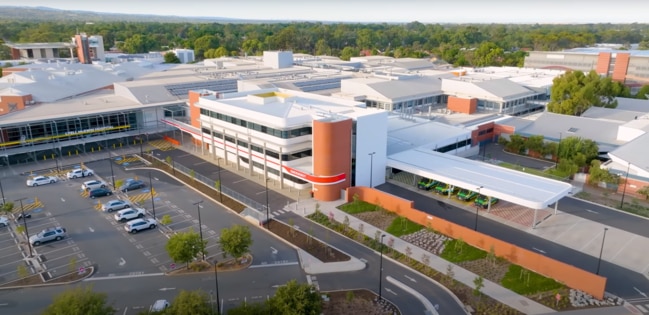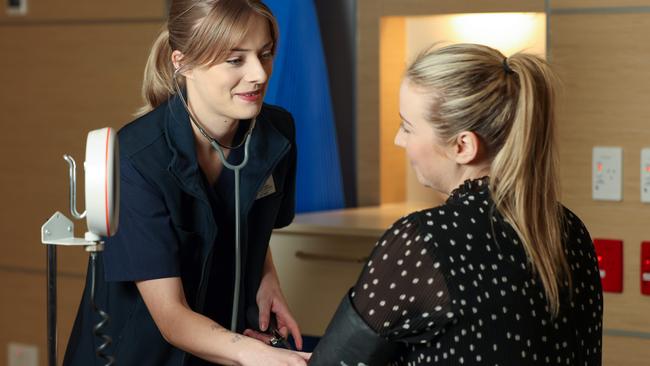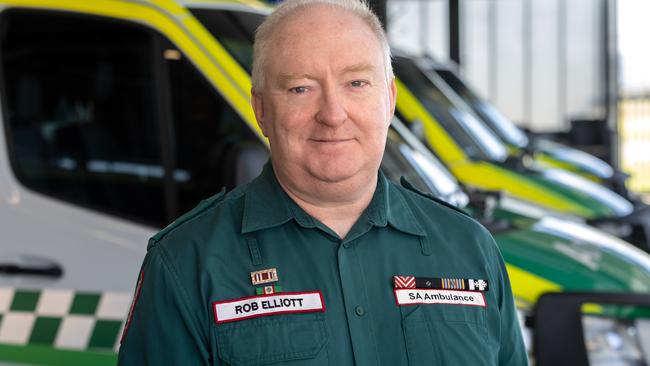Investment in SA hospitals to help free up more beds
The State Government is investing in the health of South Australians by building new and upgrading existing hospitals and improving facilities across the board.
SA News
Don't miss out on the headlines from SA News. Followed categories will be added to My News.
Healthcare is a cornerstone of a thriving society; fundamental to the fabric of a successful community.
A robust health system plays a crucial role in ensuring everyone can enjoy their best lives, providing access to appropriate care precisely when it’s needed most – and often in moments of crisis.
During these critical times, people can feel confident in the healthcare infrastructure supporting them.
Indeed, few aspects of public service carry more significance than a well-functioning, accessible healthcare system.
A raft of initiatives – from new and upgraded hospitals and ambulance stations to comprehensive mental health services – are now being implemented across the state as part of the State Government’s drive to deliver a bigger health system.
Making a SWIFT improvement
The State Government is investing in the health of South Australians by increasing the number of hospital beds, upgrading existing hospitals and improving facilities across the board to ease pressure on hospitals, staff and patients.
As part of its major expansion of the health system, more than 600 new beds will be opened across the state, including 112 at the Queen Elizabeth Hospital, 72 at Modbury Hospital, 56 at the new Women’s and Children’s Hospital and 228 in the south of Adelaide at Flinders Medical Centre, Noarlunga and the Repat Health Precinct.
Forty-eight new beds recently opened at the Lyell McEwin Hospital, where Dr Toby Gilbert, divisional director (medical), Northern Adelaide Local Health Network (NALHN), says the benefits were immediately felt.
“The numbers of patients waiting in parts of the Lyell McEwin which provide flexible areas to assist in meeting excess demand, has fallen,” he says.
“We also have fewer patients queuing for beds every morning in the ED. On one Thursday afternoon we had zero patients waiting for beds in the Lyell McEwin and Modbury hospitals. In living memory, that hasn’t happened before.”

The extra beds at the Lyell McEwin are also taking the pressure off demand at other metropolitan hospitals. “Monitoring the hospital capacity is something we do daily,” Dr Gilbert says. “It’s an interconnected system – by opening 48 beds here, we can impact queuing at the RAH and Flinders.”
New artificial intelligence-based technology is another valuable tool in the patient care toolbox. Dr Gilbert has led the introduction of SWIFT, the Supportive Weekend Interprofessional Flow Team.
Utilising clinicians’ expertise and artificial intelligence (AI) algorithms, the program is targeted at helping discharge-ready patients to get home on weekends.
Traditionally, weekend discharges are less than half the number occurring on weekdays, even though patients are equally capable of being discharged on weekends.
SWIFT enables clinicians to free up beds on weekends for incoming patients, while shortening patients’ length of stay and reducing their risk of hospital-acquired complications and functional decline. Ultimately it improves the overall efficiency of healthcare delivery at the Lyell McEwin Hospital.
“You need to start thinking about weekend discharge on a Thursday,” Dr Gilbert says. “SWIFT identifies those patients who are ready for or getting close to discharge. We give the SWIFT team a little bit of firepower – if the patient needs physiotherapy, equipment or services to help achieve a safe and appropriate discharge, we can organise that straight away, rather than waiting until after the weekend.”
The combination of technology and medical experts is having a significant impact, with an extra 25 per cent of patients at the Lyell McEwin Hospital able to secure a weekend discharge through SWIFT. The model will next be rolled out at Modbury Hospital. NALHN is also working with CALHN (Central Adelaide Local Health Network) and SALHN (Southern Adelaide Local Health Network) to trial the program there.
“We all have patients to discharge on a weekend and we all thought it was an immovable problem but the solution is showing some benefit,” Dr Gilbert says. “There are no magic bullets but we did manage to increase the number of patients going home from the Lyell McEwin over the weekend so our Monday mornings are better now.”
Health in safe hands
Significant investment in the health sector is creating new employment opportunities for South Australians and a strong workforce equipped to meet the growing demand for services.
Since 2022, the State Government has recruited more than 1400 additional health workers across nursing, doctors, ambulance and allied health roles. A breadth of employment opportunities continue to arise for those who wish to pursue a career in the health sector, including registered nurses, midwives, doctors, paramedics, allied and scientific health, and mental health workers.
In addition to employment opportunities, there is a strong focus on providing staff with all the training, tools and support needed to build an enriching professional career.
Registered nurse Charlotte Stott-Noakes is enrolled in the 12-month Transition to Professional Practice Program (TPPP), developed by SA Health to help the transition from student nurse to registered nurse.

“The TPPP comes with a lot of support including professional development days and a lot of self-care advice and education – things like how to get through shift work, night shifts and avoid burn out,” the 23-year-old says. “It also covers specific topics such as an introduction to palliative care and working with difficult behaviours – they take the time to outline things you might need extra help with. If you ever need any assistance on the ward, you can call and someone will help you straight away.”
While that extra support ends after completion of the program, Stott-Noakes is confident the training and experience she has received will stand her in good stead. “Next year, once I finish my TPPP, I won’t have that phone number to call for assistance, people won’t be checking on me but hopefully with all the education they give me in my first year, I’ll be comfortable and competent to work independently,” she says.
Peer support is also key. “It’s a little bit overwhelming when you start working on the ward but there are a lot of senior staff around – I go to them straight away whenever I have a question,” she says. “I find a lot of nurses enjoy teaching, sharing their knowledge with the younger staff.”
Her current rotation on the respiratory ward has opened up a potential new career pathway for Stott-Noakes. “The rotations mean you end up in an area you never thought you’d be in and real life is different to what you thought it would be,” she says. “I’ve always enjoyed critical care nursing – I was interested in emergency but now that I have been working on the respiratory ward I’m also quite keen on working on heart and lungs.
“The good thing about nursing is that throughout your career you can change where you go. There are plenty of opportunities. It’s good to know that no matter my circumstances there’s always going to be a job that will suit me.”
Emergency help at hand
Rob Elliott describes the past two years at SA Ambulance Service (SAAS) as “the biggest episode of growth” he has witnessed in his 35 years at the organisation.
The service has recruited 112 new metropolitan paramedics and 48 country paramedics as of the end of July 2024, along
with 36 metropolitan emergency support service ambulance officers, 20 clinical leaders, 15 emergency medical dispatchers and 24 regional medical transfer services officers.
In terms of infrastructure, new ambulance stations have been completed and are now open at Norwood, Woodville, Edwardstown, Port Augusta, Birdwood and Strathalbyn, with construction recently commenced on the new Gawler station and the Campbelltown station rebuild imminent.
And there’s more to come.
Overall, the campaign will see 350 more paramedics, ambulance officers, clinical leaders and emergency medical dispatchers across the state, along with 24 new, upgraded or completely rebuilt ambulance stations and 36 more ambulances on the road by 2026.
“It is the biggest episode of growth I have seen in my 35 years at SAAS,” chief executive Elliott says. “The fact we have been able to achieve it is extraordinary.
“It’s a whole-of-organisation effort – this has affected our fleet department in terms of new ambulances, corporate services in terms of the new builds.

“Our operational recruitment team and operational training staff have had to bring people in, our leaders have more students and staff to look after and mentor. It’s been a fantastic couple of years.”
The investment has resulted in significant improvements in emergency response times. “Our lights and sirens responses are priority one and priority two,” Elliott says. “Priority twos are the majority of our responses and we have managed to effectively double our performance in the past two years, which is just extraordinary. And we’re not stopping yet – we’re striving to improve even more.”
A flagship new SA Ambulance Service Precinct, including an Emergency Operations Centre, State Health Co-ordination Centre and Adelaide Ambulance Station at Mile End South will be a game-changer for SAAS, providing the space and technology to manage a modernised ambulance service, while a new team of 20 specialised ambulance officers have been recruited to better transfer patients out of hospitals, getting them home sooner and freeing up beds for others.
SAAS will also be introducing an electronic patient care record (ePCR) system to improve patient safety in the field, expanding the clinical telephone assessment service and expanding a mental health focused role 24/7.
“That’s an absolute innovation here in South Australia,” Elliott says. “We partnered with the Hospital Research Foundation to trial having a dedicated 24/7 mental health focused service. The trial was really successful, offering patient safety and some really good outcomes, so with the recent investment we are turning that into a 24/7 service.
“I think it is one-of-a-kind in Australia – I haven’t seen anything quite like it, a paramedic providing dedicated mental health support. I’m pretty proud of that one. Mental health is a growing consumer group for us. Paramedics are excellent at offering a generalist approach, including mental health, but for the lower acuity cases where the community mental health service is a better response than transport to hospital, this role is brilliant for that.”
Originally published as Investment in SA hospitals to help free up more beds



